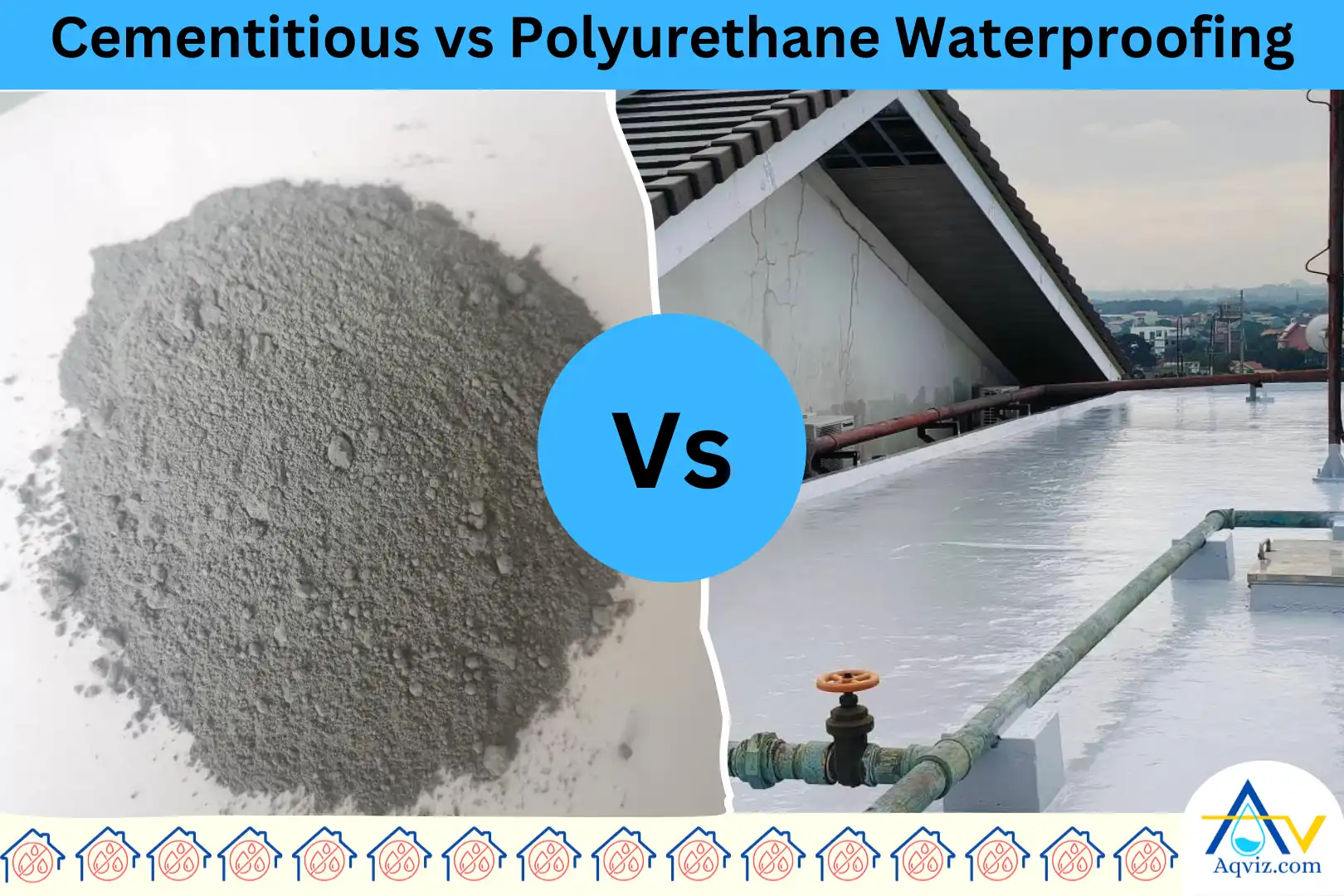Cementitious vs. Polyurethane Waterproofing: What Are the Differences?

Cementitious waterproofing and Polyurethane waterproofing are two types of most used waterproofing membranes, which are used to protect buildings from water and moisture penetration. In order to choose the right type of the waterproofing membrane, you should know the differences between them before you apply.
So as waterproofing experts, Aqviz, we prepared a complete comparison guide by considering the cementitious vs Polyurethane waterproofing. We have included main differences in material composition, water resistance, breathability, flexibility, chemical resistance, and UV resistance. As minor differences, we included adhesion, tear resistance, seam integrity, root penetration resistance, eco-friendliness, fire resistance, anti-slip resistance, toxicity and self-expanding capability.
Material Properties Comparisons Between Cementitious and Polyurethane Waterproofing
These are the material composition, performance, durability, and environmental resistance comparisons between cementitious and polyurethane waterproofing
- Cementitious waterproofing is a cement-based coating , while polyurethane waterproofing is a mixture of synthetic polymers .
- Cementitious waterproofing and polyurethane waterproofing are both highly water resistant.
- Cementitious waterproofing and polyurethane waterproofing are highly breathable waterproofing membranes.
- Cementitious waterproofing is not flexible , while polyurethane waterproofing is highly flexible.
- Cementitious waterproofing has a moderate chemical resistance while Polyurethane waterproofing has a superior chemical resistance.
- Cementitious waterproofing has a limited UV resistance compared to polyurethane waterproofing.

Composition Difference Between Cementitious and Polyurethane Waterproofing
Cementitious waterproofing is a cement-based coating , while polyurethane waterproofing is a mixture of synthetic polymers
Cementitious waterproofing is a cement-based coating that consists of mainly portland cement, kaolin, and minor additives such as marble dust or silica sand, lime, ground salt, alum stone, or calcium chloride. When it mixes with water, it forms a rigid and durable barrier against water. Hence, it can be applied on the concrete surface to stop water leaking and seeping.
Polyurethane waterproofing is composed of synthetic polymers derived from a reaction between polyols and isocyanates. It forms a seamless, super elongated elastomeric membrane when it is applied on the substrate. It can be applied mostly on upper-grade applications.
There are more than 10 types of waterproofing membranes available for building waterproofing. If you need to know about all of them, read our expert guide about 10 Types of Waterproofing Membranes: Properties, Applications, Pros, and Cons
Water Resistance Difference Between Cementitious and Polyurethane Waterproofing
Cementitious waterproofing and polyurethane waterproofing are both highly water resistant.
Cementitious waterproofing is highly resistant to hydrostatic pressure. Hence it can be used for water tanks, basements, and swimming pools. The cement-based composition allows it to bond permanently with concrete, ensuring long-term protection against water seepage.
And also, polyurethane waterproofing offers superior water resistance due to its seamless and elastic nature. It forms a continuous membrane that adapts to surface movements and prevents water infiltration even in dynamic conditions.
Breathability Differences Between Cementitious and Polyurethane Waterproofing
Cementitious waterproofing and polyurethane waterproofing are highly breathable waterproofing membranes.
Cementitious waterproofing is highly breathable due to its higher porosity nature. It allows moisture vapors to escape from the substrate. This makes it suitable for concrete walls and basements. This leads to mold growth and structural deterioration on the concrete surface over time..
As well as polyurethane waterproofing has a higher breathability. It allows to evaporate trapped moisture in the layer. It helps to reduce the condensation and minimize the mold growth and structural damages over time due to vapor.
Flexibility Difference Between Cementitious and Polyurethane Waterproofing
Cementitious waterproofing is not flexible, while polyurethane waterproofing is highly flexible.
One of the major drawbacks of cementitious waterproofing is its rigidity. Once cementitious is applied and cured, it forms a hard, inflexible layer on the concrete surface. If there is any small movement on the structure, it can be cracked easily.
But polyurethane waterproofing is highly flexible and can stretch to accommodate structural shifts, temperature changes, and minor cracks. It has a superior elongation capacity (up to 600%) even at the low temperature. Hence it can be used for building waterproofing even in low temperatures and small movements.
Chemical Resistance Difference Between Cementitious and Polyurethane Waterproofing
Cementitious waterproofing has a moderate chemical resistance while Polyurethane waterproofing has a superior chemical resistance.
Cementitious waterproofing has moderate chemical resistance, making it suitable for water treatment plants, swimming pools, and sewage systems. It can withstand exposure to alkalinity, mild acids, and sulfates commonly found in concrete environments. However, it is vulnerable to strong acids and aggressive chemicals, which can break down the cementitious structure over time.
Polyurethane waterproofing provides excellent chemical resistance, making it highly durable in industrial and harsh environments. Polyurethane waterproofing is resistant to aggressive chemicals, solvents, and oils, due to their chemically inert polymeric structure. Hence, it can be used for many chemical based substrate structures.
UV Resistance Difference Between Cementitious and Polyurethane Waterproofing
Cementitious waterproofing has a limited UV resistance compared to polyurethane waterproofing.
Cementitious waterproofing has a lower UV resistance compared to polyurethane waterproofing. The primary reason for its poor UV resistance is its cement-based composition, which lacks the necessary polymers to withstand direct ultraviolet exposure.
But polyurethane waterproofing has outstanding UV resistance. It can withstand stable with maintaining elasticity, color stability and protective performance over time due to its inherent UV-resistant additives in its chemical formulation.
Read our similar expert guide related to cementitious waterproofing
- Cementitious vs EPOXY waterproofing
- Cementitious vs Bituminous waterproofing
- Bituminous vs Polyurethane waterproofing

Functional and Environmental Impact Comparisons Between Cementitious and Polyurethane Waterproofing
These are the mechanical strength, safety, environmental impact, and usability comparisons between cementitious and polyurethane waterproofing
| Properties | Cementitious (X) | Polyurethane (Y) |
| Adhesion | Good on concrete, needs rough surface. | Excellent on multiple surfaces. |
| Tear Resistance | Low, prone to cracking. | High, flexible and durable. |
| Seam Integrity | Layered, potential weak points. | Seamless, no weak points. |
| Root Resistance | Moderate, may be affected. | Strong, ideal for green roofs. |
| Eco-Friendliness | Non-toxic, cement-based. | Less eco-friendly, chemical-based. |
| Fire Resistance | Naturally fire-resistant. | Some require additives. |
| Anti-Slip | Rough texture, slip-resistant. | Needs additional coatings. |
| Toxicity | Safe, potable water-friendly. | May release fumes during application. |
| Self-Expanding | No, remains rigid. | Yes, bridges small cracks. |
